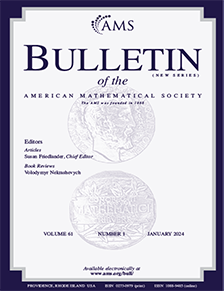The Green-Tao Theorem on arithmetic progressions in the primes: an ergodic point of view
HTML articles powered by AMS MathViewer
- by Bryna Kra PDF
- Bull. Amer. Math. Soc. 43 (2006), 3-23 Request permission
Abstract:
A long-standing and almost folkloric conjecture is that the primes contain arbitrarily long arithmetic progressions. Until recently, the only prog- ress on this conjecture was due to van der Corput, who showed in 1939 that there are infinitely many triples of primes in arithmetic progression. In an amazing fusion of methods from analytic number theory and ergodic theory, Ben Green and Terence Tao showed that for any positive integer $k$, there exist infinitely many arithmetic progressions of length $k$ consisting only of prime numbers. This is an introduction to some of the ideas in the proof, concentrating on the connections to ergodic theory.References
- Antal Balog, The prime $k$-tuplets conjecture on average, Analytic number theory (Allerton Park, IL, 1989) Progr. Math., vol. 85, Birkhäuser Boston, Boston, MA, 1990, pp. 47–75. MR 1084173, DOI 10.1007/978-1-4612-3464-7_{5}
- Antal Balog, Linear equations in primes, Mathematika 39 (1992), no. 2, 367–378. MR 1203292, DOI 10.1112/S0025579300015096
- V. Bergelson, Weakly mixing PET, Ergodic Theory Dynam. Systems 7 (1987), no. 3, 337–349. MR 912373, DOI 10.1017/S0143385700004090
- V. Bergelson and A. Leibman, Polynomial extensions of van der Waerden’s and Szemerédi’s theorems, J. Amer. Math. Soc. 9 (1996), no. 3, 725–753. MR 1325795, DOI 10.1090/S0894-0347-96-00194-4
- Jean-Pierre Conze and Emmanuel Lesigne, Sur un théorème ergodique pour des mesures diagonales, C. R. Acad. Sci. Paris Sér. I Math. 306 (1988), no. 12, 491–493 (French, with English summary). MR 939438 ET P. Erdös and P. Turán. On some sequences of integers. J. London Math. Soc., 11 (1936), 261-264. FJU M. Frind, P. Jobling and P. Underwood. $23$ primes in arithmetic progression. Available at http://primes.plentyoffish.com/
- Harry Furstenberg, Ergodic behavior of diagonal measures and a theorem of Szemerédi on arithmetic progressions, J. Analyse Math. 31 (1977), 204–256. MR 498471, DOI 10.1007/BF02813304
- H. Furstenberg and Y. Katznelson, An ergodic Szemerédi theorem for commuting transformations, J. Analyse Math. 34 (1978), 275–291 (1979). MR 531279, DOI 10.1007/BF02790016
- H. Furstenberg and Y. Katznelson, A density version of the Hales-Jewett theorem, J. Anal. Math. 57 (1991), 64–119. MR 1191743, DOI 10.1007/BF03041066
- Hillel Furstenberg and Benjamin Weiss, A mean ergodic theorem for $(1/N)\sum ^N_{n=1}f(T^nx)g(T^{n^2}x)$, Convergence in ergodic theory and probability (Columbus, OH, 1993) Ohio State Univ. Math. Res. Inst. Publ., vol. 5, de Gruyter, Berlin, 1996, pp. 193–227. MR 1412607 GY D. Goldston and C. Y. Yildirim. Small gaps between primes, I. Preprint.
- W. T. Gowers, A new proof of Szemerédi’s theorem, Geom. Funct. Anal. 11 (2001), no. 3, 465–588. MR 1844079, DOI 10.1007/s00039-001-0332-9 Granville A. Granville. Personal communication. Gr B. Green. Roth’s Theorem in the primes. To appear in Ann. Math. GT B. Green and T. Tao. The primes contain arbitrarily long arithmetic progressions. To appear, Ann. Math. GT2 B. Green and T. Tao. A bound for progressions of length $k$ in the primes. Preprint. HL G. H. Hardy and J. E. Littlewood. Some problems of “partitio numerorum” III: on the expression of a number as a sum of primes. Acta Math., 44 (1923), 1–70.
- D. R. Heath-Brown, Three primes and an almost-prime in arithmetic progression, J. London Math. Soc. (2) 23 (1981), no. 3, 396–414. MR 616545, DOI 10.1112/jlms/s2-23.3.396
- Bernard Host and Bryna Kra, Convergence of Conze-Lesigne averages, Ergodic Theory Dynam. Systems 21 (2001), no. 2, 493–509. MR 1827115, DOI 10.1017/S0143385701001249 HK B. Host and B. Kra. Nonconventional ergodic averages and nilmanifolds. Ann. Math., 161 (2005), 397–488. HK2 B. Host and B. Kra. Convergence of polynomial ergodic averages. Israel J. Math., 149 (2005), 1–19. L A. Leibman. Convergence of multiple ergodic averages along polynomials of several variables. Israel J. Math., 146 (2005), 303–316. M F. Mertens. Ein Beitrag zur analytischen Zahlentheorie. Journal für Math., 78 (1874), 46–62.
- Paul A. Pritchard, Andrew Moran, and Anthony Thyssen, Twenty-two primes in arithmetic progression, Math. Comp. 64 (1995), no. 211, 1337–1339. MR 1297475, DOI 10.1090/S0025-5718-1995-1297475-1
- Atle Selberg, The general sieve-method and its place in prime number theory, Proceedings of the International Congress of Mathematicians, Cambridge, Mass., 1950, vol. 1, Amer. Math. Soc., Providence, R.I., 1952, pp. 286–292. MR 0044563
- E. Szemerédi, On sets of integers containing no $k$ elements in arithmetic progression, Acta Arith. 27 (1975), 199–245. MR 369312, DOI 10.4064/aa-27-1-199-245 T T. Tao. A quantitative ergodic theory proof of Szemerédi’s theorem. Preprint. T2 T. Tao. A remark on Goldston-Yildirim correlation estimates. Preprint. VDC J. G. van der Corput. Über Summen von Primzahlen und Primzahlquadraten. Math. Ann., 116 (1939), 1–50. VDW B. L. van der Waerden. Beweis einer Baudetschen Vermutung. Nieuw Arch. Wisk., 15 (1927), 212–216. Z T. Ziegler. Universal characteristic factors and Furstenberg averages. Preprint.
Additional Information
- Bryna Kra
- Affiliation: Department of Mathematics, Northwestern University, 2033 Sheridan Rd., Evanston, Illinois 60208-2730
- MR Author ID: 363208
- ORCID: 0000-0002-5301-3839
- Email: kra@math.northwestern.edu
- Received by editor(s): July 20, 2005
- Published electronically: October 6, 2005
- Additional Notes: This article is an expanded version of a lecture presented January 7, 2005, at the AMS Special Session on Current Events, Joint Mathematics Meetings, Atlanta, GA. The author was partially supported by NSF grant DMS-0244994.
- © Copyright 2005
American Mathematical Society
The copyright for this article reverts to public domain 28 years after publication. - Journal: Bull. Amer. Math. Soc. 43 (2006), 3-23
- MSC (2000): Primary 11N13, 37A45, 11B25
- DOI: https://doi.org/10.1090/S0273-0979-05-01086-4
- MathSciNet review: 2188173


